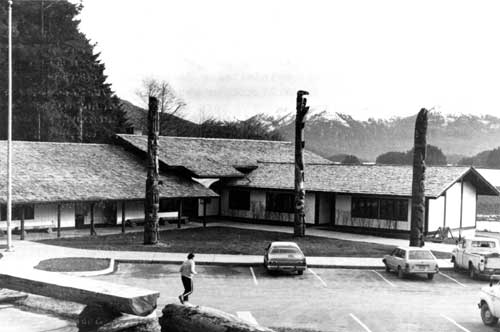|
SITKA
Administrative History |

|
Chapter 5:
SITKA NATIONAL HISTORICAL PARK, 1966-1986 (continued)
| RESOURCE ISSUES |
Visitor center and fort site
Shortly after the visitor center opened in 1965, permanent interpretive exhibits relating to the Tlingits, Russians, and the battle that the park commemorates, were placed in one wing of the building. Reginald Butcher from the Western Museum Laboratory and Edward Pilley from the Western Regional Office spent two weeks in March 1966 installing the exhibits. Sheldon Jackson Museum loaned the park 25 Tlingit pieces that were used in the display. These pieces will be returned to the museum when the new exhibits are installed in the visitor center. The park service staff hosted a preview of the exhibits for local Tlingits who provided information. A total of 842 people, most of whom were Sitka residents, attended the open house at the park the weekend after the exhibits were installed. [306] Shortly after she began working at the park in 1969, Ellen Hope Lang arranged for three local Tlingit clans to indefinitely but conditionally loan the park seven houseposts, a totem pole, a carved frog totem, dance robes, and other ceremonial clothing and objects. These pieces were placed on exhibit in the visitor center. After Sheldon Jackson Museum became the property of the State of Alaska in 1985, the museum loaned all of the Russian pieces in its collection to the park. A few are currently on display; others will become part of the Russian Bishop's House exhibits.
|
|
As the Alaska Native people became more politically active following passage of the Alaska Native Claims Settlement Act in 1971 and as people became more sensitive to objective interpretations of history, particularly with respect to ethnic minorities in the United States, the Sitka visitor center exhibits were revised. In 1978 the exhibit titled "The Massacre at Old Sitka--1802" was changed to "The Destruction of Old Sitka--1802" to be less one-sided. [307] In 1979 the park contracted with Andrew Hope, a Sitka Tlingit, to write a manuscript about the totem poles at the park. Marilyn R. Knapp used the material compiled by Hope to write Carved History, the Totem Poles & House Posts of Sitka National Historical Park that was published by the Alaska Natural History Association for the park in 1983. Harpers Ferry Center designed new exhibits for the visitor center that will be in stalled in 1988.
In 1979 the park staff, with counsel from Denver Service Center and Harpers Ferry Center, established the park's policy regarding collections of artifacts and manuscripts. Although not actively collecting, the park had acquired a collection of artifacts and archival materials. There were 492 pieces for the Tlingit fort site and Redoubt St. Michael (Old Sitka) site. The latter site was excavated during the 1930s. Objects recovered included iron nails and spikes, tools and pieces of tools, ceramic fragments, bricks, and charcoal. The park also had a collection of 136 Indian baskets.
The collections policy stated that the park would conserve Native and Russian objects as opposed to restoring them. Major additions to the collection were not necessary. The park would accept donations, and on occasion, long term loan of items relating directly to the 1804 battle, items of Tlingit or Russian culture not represented in the park's collection, and items relating to the 1867 transfer of Alaska and the influence of American occupation on the Tlingits and the Russians. The policy statement suggested that the artifacts from the archeological sites (including excavations at the Russian Bishop's House) not selected for display be placed in storage or, in the case of the materials from Redoubt St. Michael, be turned over to the State of Alaska. During 1984, 1985, and 1986 the park received funding to work on the collections. More than 1,000 artifacts were cataloged and their condition assessed.
An addition to the visitor center for storage and exhibit of 12 totem poles was proposed by the park staff in 1979. The room was to hold 11 of the park's original totem poles and one totem carved as part of the Civilian Conservation Corps project during the 1930s. In the proposal the staff argued that a climate-controlled environment was needed to preserve the poles. [308] Funds for the addition were not forthcoming. Instead, a storage shed behind the visitor center was constructed. A maintenance building was built behind the visitor center in 1978. It had a shop and garage on the first floor, and storage and museum office on the second floor.
The wooden footbridge over Indian River had been destroyed by the river in 1961. Responding to "numerous complaints," a new footbridge was designed by Romaine Hardcastle and built by the Neighborhood Youth Corps. On August 9, ten days after the footbridge was completed, a log jam broke in the river above the bridge and tore the bridge out. [309] The present park footbridge, built of wood and concrete, that spans Indian River was constructed in 1968. In 1980 a new trail, called the "Battleground Trail," was added in the park. It went around the edge of the 1804 battle site. Employees hired under the Comprehensive Employment and Training Act (CETA) "loaned" to the park service from the U.S. Forest Service built the trail. Alaska Lumber and Pulp Company at Sitka donated the wood chips for the trail. To emphasize their importance to the park, the Tlingit fort site and the battle site were landscaped that same year. The fort site area was scarred from the trenches dug in 1970 for the totem pole treatment program. Park staff coordinated with the State Historic Preservation Officer who concurred with the park service's determination that the landscaping would not adversely impact the site. [310] Also in 1980, the park had a physical fitness trail in stalled on the north side trail.
| <<< Previous | <<< Contents>>> | Next >>> |
sitk/adhi/adhi5e.htm
Last Updated: 04-Nov-2000
